|
Caribbean Slow Roasted Jerk Pork
A real party centrepiece and an ideal dish for a celebration! A Caribbean breath of allspice and nutmeg rises from the roasting tin along with the hot tingle of chilli. Guests serve themselves to the tender spicy meat, enjoying the rich aroma. Spoon the meat over freshly cooked rice, add a scoop of black beans, a dollop of charred pineapple salsa and a dab of creamed avocado and you have a meal to please all the crowd. You can make the pork up to two days ahead, warm it up in the oven when you need it. It’s very tolerant of standing for an hour if covered, so there’s no last-minute dash or standing over a hot stove while your guests drink all the Mojitos. This recipe is another one from my Christmas in the Caribbean menu which will be on the website in a couple of weeks as a fully worked out party menu suggestion, from cocktails to Cake de Ron. Serves 10 Timings: Overnight marinade, then 4-5 hours cooking
Put all the marinade ingredients in bowl and blend to a paste. Cover the pork with the paste, massaging into the flesh, and in the gaps of the rind. You might want to wear cooking gloves to do this or be sure to wash your hands extremely well afterwards as you’ll regret touching your eyes with hands that have been peeling Scotch bonnets. Place the pork in a dish (you can cut it in two if it makes it easier) and leave overnight in the fridge, turning occasionally. But you don't have to get up in the night to turn it, just do it before you go to bed. Pre heat the oven to 165°C. Place the pork in a roasting tray, skin upwards, and cover with kitchen foil. Roast for 90 minutes, then turn up the heat to 180°C. Roast for another 2 hours. Every now and then pour off the cooking juices into a jug - there will be quite a lot and it will separate into the fatty part and the meat juices which carry a lot of flavour. Take the cover off the meat and roast for another hour to let the skin start to cook down into the meat. Take the roasting tray out of the oven, drain away the juices and carefully separate the skin away from the pork. Remove the skin and discard. (You can separately sizzle up the crackling later by frying in deep fat if you like.) Pull the bones and any cartilage parts out of the soft and tender meat and tear the meat into shreds with two forks. Place back in the oven while you make the sauce. Separate the meat juices from the fat. Pour the juices into a pan and boil down until reduced by at least half – taste as you go along and experience how the flavour deepens. Add the chilli sauce and sweet chilli sauce and the balsamic vinegar. Continue to simmer for a few minutes. When you have a glossy sharp-smelling sauce, pour it over the meat in the roasting tin and mix well. Roast for a further 30 minutes, turning every now and then so the sauce is absorbed and the meat is starting to char at the edges of the tin. You can add a shake of Tabasco and a sprinkle of salt and pepper before serving if you think it needs extra spice. The meat in its sauce keeps warm in the oven if covered, so you can leave it now until your guests arrive and get on with the other things, or make it a day or so ahead and warm up as needed.
0 Comments
Tom Yum Noodle Soup (pescatarian or vegan option)
Maybe this is an odd memory to associate with Dublin. You’d think oysters, Guinness, champ. But I used to catch an early plane to Dublin on a regular basis and meet colleagues in the airport. I’d been up so early, the meal felt like lunch to me and I didn’t fancy bacon and eggs, so we used to gather at the food court, and indulge in a Tom Yum soup. The combination of spice and creamy coconut, Thai red curry and coriander, tender prawns and juicy mushrooms was exactly right to re-set my inner clock and perk me up ready for the afternoon meetings. I still find that a home made version makes an energising and easy lunch, if you keep a few staples around. I like the base made with chicken stock, of which I usually have a plentiful supply in the freezer, but you can make it with vegetable stock and use a stock cube. Infusing the stock with the aromatics is a key part of the recipe but you could do this ahead of time, reduce the stock again and keep it in the fridge to assemble the meal with only a few minutes notice. A combination of prawns and chicken is traditional but you can change around the protein and the vegetables to suit your tastes and what you have in the house. Some chopped mushrooms add that chewy texture and contrast very nicely with the slippery rice noodles, so mushrooms, courgette and spring onion would make a good vegan option, maybe with some sliced baby corn for the protein. Try it and leave me a comment, I’d love to hear other versions. Serves 4 Timings: 1 hour
Heat up your stock and add the infusion ingredients. Let it simmer for a few minutes and then leave to cool down with the spices in the liquid. Strain the stock, discard the spices. As above, you can poach the chicken breast in the stock while you do this. Warm up the stock in your soup pan, add the Thai red curry paste and stir in well. Add the chopped green vegetables, the mushrooms and most of the spring onions, simmer for a few minutes. Add the prawns and the chicken pieces. Add the fish sauce and the lime juice to the soup, bring to a simmer and cook for about 3 minutes. Add the coconut milk to the pan and bring to a slow simmer – do not boil vigorously as this can curdle the milk. Add the rice noodles in, stir and simmer for 2-3 minutes to soften the noodles, they don’t need a lot of cooking. Taste and adjust the seasoning, you might need a touch more lime juice or a little shot of soy. Sprinkle with coriander and the remaining chopped spring onions to serve. Chicken Satay Skewers
Sizzling like a hive of bees, street food smells waft from the open grills in Petaling Street Market in Kuala Lumpur. Tourists and locals flock to eat skewers of satay meats and prawns, crowded on benches, elbows in each other’s sides. The delicate meat, marinated in spices and drizzled with peanut sauce, is quickly grilled over high heat to sear the outside and give it that smoky crunch. The street vendors whip the bamboo skewers off the coals and throw them onto flat banana leaves, used as plates. Delicious! Manchester is a long way from Malaysia, and the recipe for Satay has travelled a long way itself since it started in Indonesia. It’s always been a street food – meat is kept in a marinade, threaded onto skewers and grilled over hot coals as customers order it. You can make a really good imitation at home under the grill but it would be even better on the barbeque. As the recipe moved through the far East, the marinade took on different characters according to the cultures. The Thai version uses coconut milk in the marinade, which gives a creamier result than the original lime, turmeric and spice marinade. As a street food, you just eat the meat from the skewers, but at home you can make some plain rice, relishes, pickles and green vegetables to turn it into a full meal. Serves 4 Timings: 4 hours to marinade, about 30 minutes to assemble the meal
Marinade:
Satay sauce:
Relishes: mango, red onion, chilli and lime salsa; red onion slices pickled in vinegar with a teaspoon of sugar and salt added; sliced cucumbers; brined chilli peppers from a jar. Make up the marinade, mix well. Add the chicken strips and marinade for 4 hours or overnight. The turmeric gives a lovely golden colour to the meat over time. To make the sauce, mix all the ingredients together in a small bowl and gradually add in cold water, a spoonful at a time, whisking in as you go. Keep going until you get a thick glossy sauce of the right consistency to spoon over the kebabs. Soak your bamboo skewers in water for an hour before cooking. Thread the chicken pieces onto the bamboo skewers, concertina-ing up the strips. You will need 2-3 skewers per person. Grill the skewers under a hot grill, turning now and then. They will take about 10 minutes to cook through under a grill, or a little less on a barbeque. Serve with plain rice, the tasty relishes and salsa, and maybe some steamed pak choi or tender stemmed broccoli drizzled with sesame oil. Or wrap them in a tortilla wrap and slather them with sauce. Schupfnudeln (vegetarian optionally)
They sound odd, but they’re plump and fluffy and delicious, and surprisingly easy to make. They’re the German equivalent of the Italian gnocchi, which gives you an idea of the texture. The name just means “pinched dumplings” which indicates that you don’t need a machine to make them. They’re not usually eaten with a tomato sauce (for no good reason that I can think of, it’s one of those “just so” questions), but are fried up with some well flavoured meat, soaking up the fat and pan juices. In the Munich Christmas Market you will find schupfnudeln billowing their savoury smell along the alleys of wooden huts, heaving with woolly-wrapped merry makers. The dumplings are fried up with smoked bacon, sweet onions, tangy sauerkraut and a sprinkling of caraway seeds for a very characteristic taste. Spear them with a fork; and enjoy a genuine continental Christmas treat. Preparation: Peeling and boiling potatoes – 30 minutes. Then making the dumplings – 1 hour. Final preparation – 20 minutes.
Mix the mashed potato, flour and eggs together, season with salt and pepper. Use your hands to form a soft dough and mix well, but don’t knead. Cover the dough and chill in the fridge while you bring a large pan of salted water to the boil. Remove 1/6th of the dough from the lump. Roll it on a floured worktop, like rolling playdough into a long snake about 2cm thick. Pinch off pieces about 2cm long and roll on your palm - the shape of your hand will naturally make a worm-shaped piece of dough, thinner at the ends than at the middle. This is what you want. Roll about 25 pieces like this and drop them into the boiling water. Don’t overload the pan, you want the water to retain the heat and boil the batch up quickly. They will rise to the top and expand as they cook, taking about 1-2 minutes. Scoop out the cooked dumplings and place them on a fine wire rack or on a tea towel, so they don’t sit in liquid. Keep going until you’ve done all the dough. You get quicker as you go along! At this stage you can cool your schupfnudeln and keep them for a day covered in the fridge until you want to cook them. You can also freeze them on a metal tray and put them in a bag once frozen. Cook straight from frozen, without thawing if you do this. About 30 minutes before eating, start to fry your bacon in your largest frying pan in a generous amount of vegetable oil. Fry until browned and starting to crisp, then add your onions to the pan. Fry for a few minutes until transparent and starting to brown and then add the shredded cabbage. Fry for another few minutes and then add the butter to the pan. When sizzling, add the caraway seeds and tip in your schupfnudeln. Turn with a spatula to brown all sides and warm through, then add the sauerkraut to the pan. Fry a little longer to cook through, adding a little more butter if you need. Lechon Asado - Cuban Style Slow Roasted Pork with Citrus Flavours
In Cuba and in much of South America, the Caribbean Jerk flavours and heat shade away to more subtle and softer spicing, often mixed with a tang of citrus to perk up fatty meat. Slow cooking is a great way to get the best value out of a cheaper cut and is also highly convenient for the chef. The dish can be made ahead and warmed up to feed your multitude on a special occasion. You would find Cubans eating this at Christmas or New Year as part of their festive feasting, along with black beans and yucca cooked in mojo sauce. Serves 8 Timings: overnight marinade, then 4 ½ hours slow cooking
If the pork is tied up, snip the strings and unroll the meat. If the rind and skin are on the meat, slice it off, but leaving a good layer of fat. Blend the ingredients for the mojo marinade until you get a creamy light sauce. Reserve about 1/3 of this and use the other 2/3 to rub into the meat. Marinate the meat in the fridge overnight, turning occasionally. Pre heat the oven to 160°C. Place the meat in a roasting tin and cover well with foil. Cook the meat for about 2 hours at 160°C and then turn up the heat to 180°C and roast for a further 2 hours. Every now and then pour off some of the dripping from the meat, baste, and re-cover the pork. About an hour from the end of cooking, use some of the fat from the meat drippings to start frying the sliced onions. Fry until softened and transparent but don’t let them brown or catch, you need them quite softly cooked. When cooked, let them cool a little and then blend them up with the reserved mojo. After about 4 hours cooking, remove the meat from the oven. Pour off any excess cooking liquid but leave a few spoonfuls. Shred the meat with two forks, tearing it apart and tearing it off the bones. Take out the bones. You will be left with a pile of lovely tender cooked aromatic pork meat. Now mix the mojo and onion sauce through the meat, turn with another spoonful of pan drippings and put back in the oven for the final half hour at 200°C. If you leave the meat uncovered, you will get some crispy bits around the edge and the sauce will cook down, or you can leave it covered for a juicier result. Mix again before serving and eat with plain rice, black beans and maybe some carrots cooked in citrus glaze. Chicken Scrunchers with Gochujang Dipping Sauce
A family favourite, deservedly so. Easy to do either in a frying pan or in the air fryer if you have one. I have recently acquired one and I love it for the substitution of deep frying with healthier lighter air frying. You can whip this up for an easy kids’ lunch in 20 minutes. I have written previously about my son’s fondness for Korean spicy flavours and his Mother’s Day gift of a tub of gochujang paste. We’ve used the spicy salty paste a lot and it’s still in the fridge and going strong. A little goes a long way. You can tone down the spices as suits your own family’s taste but this combination of sweet, salt and spice is a winner. I think we based the sauce recipe on Joshua Weissman’s (joshuaweissman.com) sauce for wings, but you can use it on any crunchy finger-type food. Serve with a platter of vegetable batons alongside the chicken for extra dipping and you have a great healthy meal. Serves 4 for a light meal Timings: 30 minutes
Gochujang sauce:
Vegetables for dipping: red or yellow pepper, carrots, celery etc. Whatever’s fresh and to your taste. Dip the chicken strips into the beaten egg and then into the breadcrumbs to coat and leave them on a baking tray in the fridge to set the coating. In a small saucepan, warm the oils together and briefly fry half the garlic and all the ginger until sizzling, but don’t brown them. Add in the soy, vinegar, rice wine, sugar and gochujang paste. Stir and simmer to blend. In a cup, mix the cornflour with 2 tablespoons water, then dip up a spoonful of the simmering sauce, mix into the cup, then tip the whole cupful back into the saucepan. Stir and bring to a simmer as it thickens. Let it cool a bit but keep warm. Fry the chicken pieces either in a frying pan with a small amount of oil or in the air fryer until cooked through and the coating is browned and crisp. Prepare the vegetable batons. Serve the chicken, vegetables, and the sauce together and allow everyone to dip to their heart’s content. Chicken Pesto Papardelle
Noodles, what’s not to love? Top them with grilled chicken marinated in home made pesto, and a pesto-butter sauce. How could life get better? Or easier? I love pappardelle, the wide ribbon pasta; it goes very well with any rich and well flavoured sauce like this or a deep warm ragu. I can’t forget the most wonderful wild boar ragu with pappardelle we had on a freezing May evening in a hillside town in Tuscany many years ago. The ribbons of pappardelle just held the strong meaty sauce as the mouthfuls slithered down our throats. I’ll have to research a real Italian ragu for the blog, but in the meantime, try this summer-time delight. I tried both grilling and griddling the chicken strips, but the oily marinade made them stick horribly to the griddle and frying gave a much better result as that also contributes to deepening the flavour of the sauce with all the nice juices that come off the chicken. I’ll give the recipe for home made pesto shortly, but you can also buy very good Pesto Genoese – the one made with fresh basil, which is best for matching to the chicken, rather than the kale and walnut based pestos. Serves 4 Timings: Pesto takes about 20 minutes to make, then 4 hours to marinade the chicken. Final dish takes 30 minutes to put together.
Put a pan of water on to boil for your pasta and heat up a large deep frying pan. Fry the chicken strips in a splash of oil as your pappardelle boils for its recommended time. Fry the chicken until nicely browned and cooked quite through, keep turning it to brown on all sides. It only takes a few minutes. Add the butter to the pan, allow it to melt and then add in the additional spoon of pesto. Turn the contents of the pan to mix well and add the squeeze of lemon juice and a grinding of black pepper. Drain your pasta when cooked as you like it (I prefer a touch beyond al dente) and keep a cup of the cooking water. Loosen the sauce in the frying pan with some of the pasta water and add the pasta into the pan. Mix well, scooping up all the pan juices into the noodles. Serve with some torn basil leaves and a sprinkle of grated parmesan. Dive in! Lamb Kofta Kebabs with Tahini Garlic Sauce
Lamb is the traditional meat for Kofta, although inventive people in the on-line cooking community have been doing their own versions. Thanks to #food_obsessed_girl on Instagram for the inspiration, she did a beef kofta in July and it reminded me of lovely holiday food in days gone by, so I re-created a meal I had in Athens a few years ago. Very popular with the men, especially, for some reason. Maybe it’s just my men, but it seems as if they particularly enjoy getting their hands into their food, building their own wrap just as they like it, drizzling over the exact amount of sauce. You could use a mix of beef and lamb mince if you like and you can add different chopped salad accompaniments as you like and according to what you have around. Chopped tomatoes with onion and oregano would go well, as would grilled peppers. I’ve also eaten these with chips instead of bread or rice and with a tangy lemon sauce. They’re so versatile, let loose your imagination! You really can’t go wrong. Serves 4 Timings: 1 hour
For the tahini garlic sauce: 3 tablespoons light tahini, 1 clove garlic, 2 tablespoons lemon juice, 1 tablespoon olive oil, 1 teaspoon ground cumin. To serve with the koftas: flat breads, chopped cucumbers, yoghurt mixed with fresh mint, long peppers in brine, lightly pickled red onions, saffron rice Soak some wooden skewers in water for about 20 minutes as you make the meat mixture. Using a stick blender, blitz up the onion, 2 cloves of garlic, fresh chilli, fresh parsley, and the lemon juice to make a thick paste. It will make your eyes water so try not to breathe! Add the paste to the lamb mince along with the ground spices, oregano, tomato puree and Worcester sauce. Add a good pinch of salt and a grind of pepper. Mix well with your hands. Form into short cylinder shapes about the length of your thumb around the wooden skewers and put into the fridge for 30 minutes to cool and firm up. You can get about 2 koftas on each skewer. While they’re cooling, make the sauce by blitzing all the ingredients together. Taste, adjust seasoning if needed. Get the accompaniments ready – slice cucumbers, pickle sliced red onion in red wine vinegar with a pinch of sugar and salt, mix the mint and yoghurt, warm up the flatbreads and cook a pot of plain rice with a pinch of saffron added. When the kebabs are cool and a bit firmer, grill them under a hot grill for about 4-5 minutes per side until the outside is browned and slightly crisped and the inside is still moist and fragrant. Pile the kebabs up on a platter and let everyone serve themselves as they like. Turkey Keema – not just for the kids!
Why do all kids like mince with peas? Big kids too. This is the ideal “kids’ curry”, not too spicy or in-your-face but pleasantly warming and easy to eat. It’s a great mid-week staple, simple to put together, not too high in the calories and hiding some good portions of vegetables within the sauce. Freezes well too, without the peas. Traditional Keema is made with lamb mince, which can be both expensive and rather fatty, although it does have a wonderful flavour. Using turkey mince just lightens up the dish. It’s not authentic, but it’s tasty. You can adjust the heat level by adding more chilli powder for those of more mature tastes. Serves 4 Timings: 30 minutes
Fry the mince gently in a heavy pan for a few minutes with a little splash of oil, turn and bash with a wooden spoon to coat all the mince with the oil. Add the onions and fry for a few minutes, then add the garlic, chilli and ginger. Continue to fry gently until the vegetables are softened and you can see all the mince is cooked. Put all the ground spices in a glass and add a tablespoon of water, mix to a paste and then scrape out into your pan. Stir into the meat as the spices release their aroma. Add the tin of tomatoes, and maybe half a tin of water, the tomato puree, the marmite and the Worcester sauce. Mix well and allow to simmer for 15 minutes. Add the frozen peas into the curry and stir in as they cook for about 2 minutes. Taste and test for seasoning – depending on the curry powder you used you may need to add salt, some pepper and perhaps a squeeze of lemon juice. Serve with plain rice or naan bread and some simple fresh relishes such as chopped tomato and red onion, cucumber with mint and yoghurt or a jar of mango chutney. Chipotle Shredded Chicken Tacos
A spicy saucy meat wrapped in soft warm taco, sprinkled with cheese and dolloped with avocado cream. Really, something to make you feel optimistic and friendly to the world. It’s worth getting a can of chipotles in adobo sauce from the specialist section of your supermarket or on line. I promise that once you’ve used them, you will keep on. The chipotles are a preserved chilli which is slow cooked in a tomato and spice sauce and then canned and matured. They have a sweet depth of flavour and are spicy but not burning. They mellow down into a sauce and give it a genuine flavour which your family will certainly appreciate. It’s one way to keep them from demanding an expensive and unhealthy takeaway on a regular basis! A lot of people think they have to buy one of those all-in-one packs to make Mexican food. They’re fine but because the spice blend is made up for you, you don’t get the chance to personalise the recipe or use the fresh ingredients such as lime juice or a spoonful of chipotle in adobo that make all the difference. Try it from scratch and see. You don’t really need vegetables with this as you have lots in the recipe but you could serve a salad or grilled corn if you like. Serves 4 Timings: 30 minutes, overnight marinade then 1 hour on the day of cooking
Marinade:
A little chopped fresh coriander to serve Blend all the marinade ingredients together with a stick blender to a paste. Add a splash of vegetable oil. Massage into the chicken thighs and leave in a covered bowl in the fridge overnight. Take the chicken out of the marinade and in a large heavy casserole pan such as Le Creuset, fry each thigh in a little vegetable oil. The marinade will crisp and brown a bit but that’s fine. When you’ve fried each of them on both sides for a few minutes to brown and set the outer surface, put them all back into the casserole with the remaining marinade and 1 teacup of water. Simmer for about an hour until the juices are much reduced but a few tablespoons still remain in the bottom of the pan. Let the pan cool a bit and then using two forks, pull the chicken pieces apart into shreds. They will be tender and easy to pull apart. Add the lime juice, stir everything through the sauce, taste, and adjust the seasoning. Keep warm. Warm your tacos in a frying pan or griddle, giving each a minute or so on each side and then wrapping the stack in a teatowel to keep warm. Blend the flesh of the avocado with sour cream, add salt and lime juice. Stir in some chopped fresh coriander if liked. This is avocado cream and not a true guacamole which would also contain chopped red onion, chopped chilli, chopped tomato and be much chunkier. Make your tomato/onion salsa by mixing chopped fresh tomatoes and onions together with a little salt. Warm your refried beans if using. I’m giving a recipe for home made refried beans later in August which are so delicious you could eat them by themselves. Everyone can assemble their own taco wraps, spread with smoky beans, filled with spicy chicken, topped with cheese and drizzled with avocado cream or tomato salsa. |
Some Changes - April 2022
Thanks to my friends and followers for your patience, and for your encouragement to start blogging again. Archives
April 2022
Categories
All
|

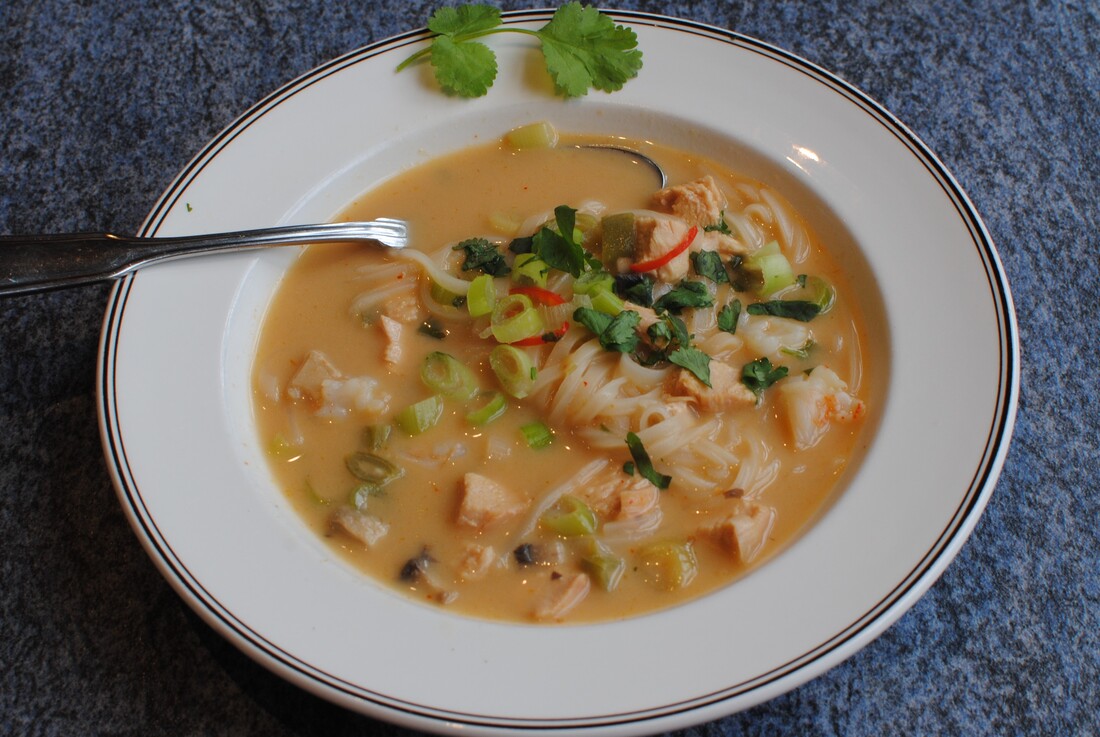

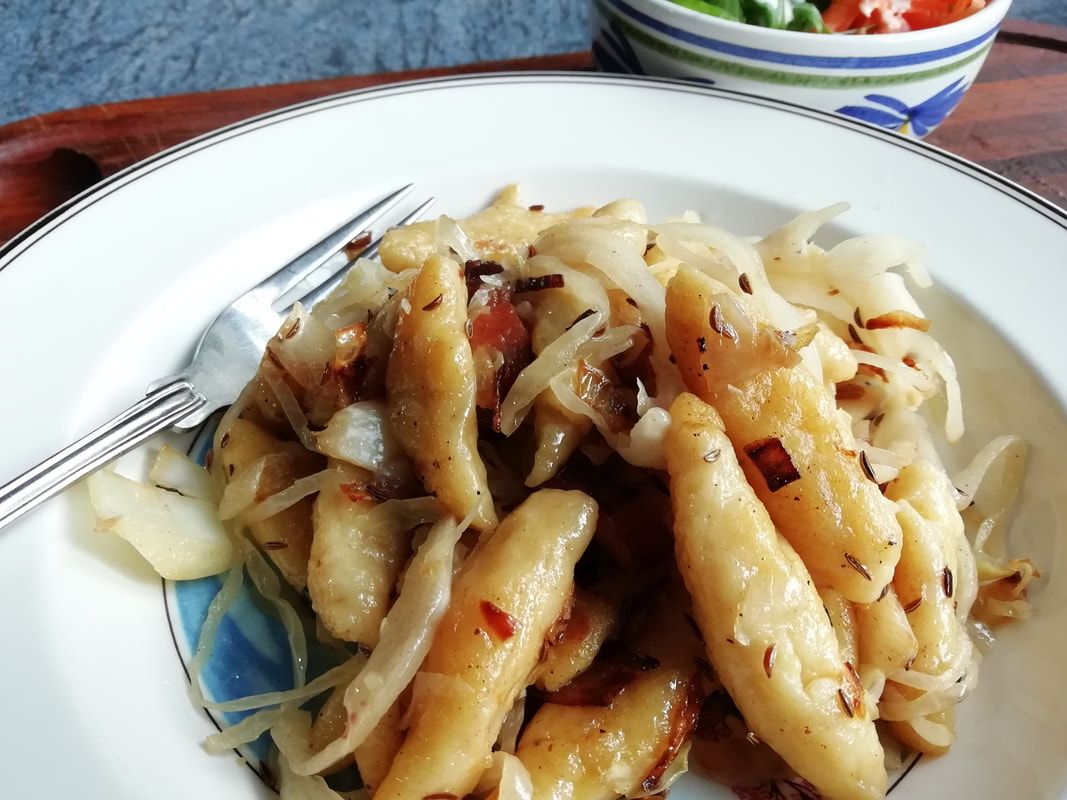

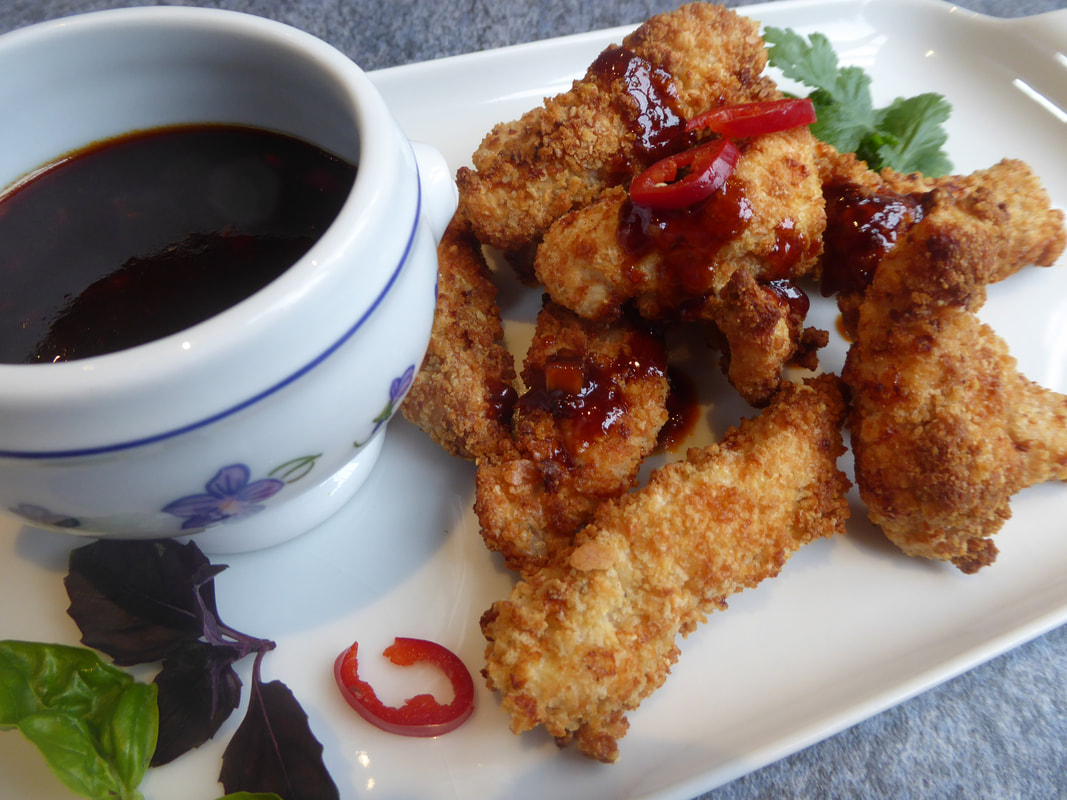
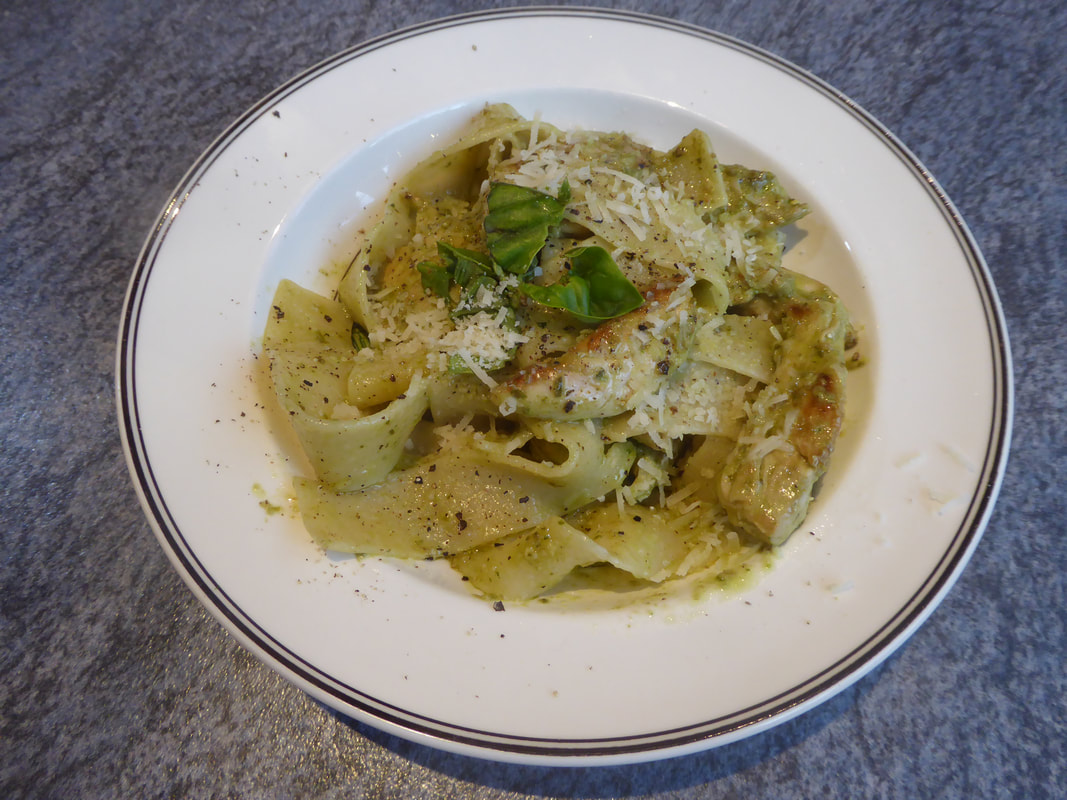
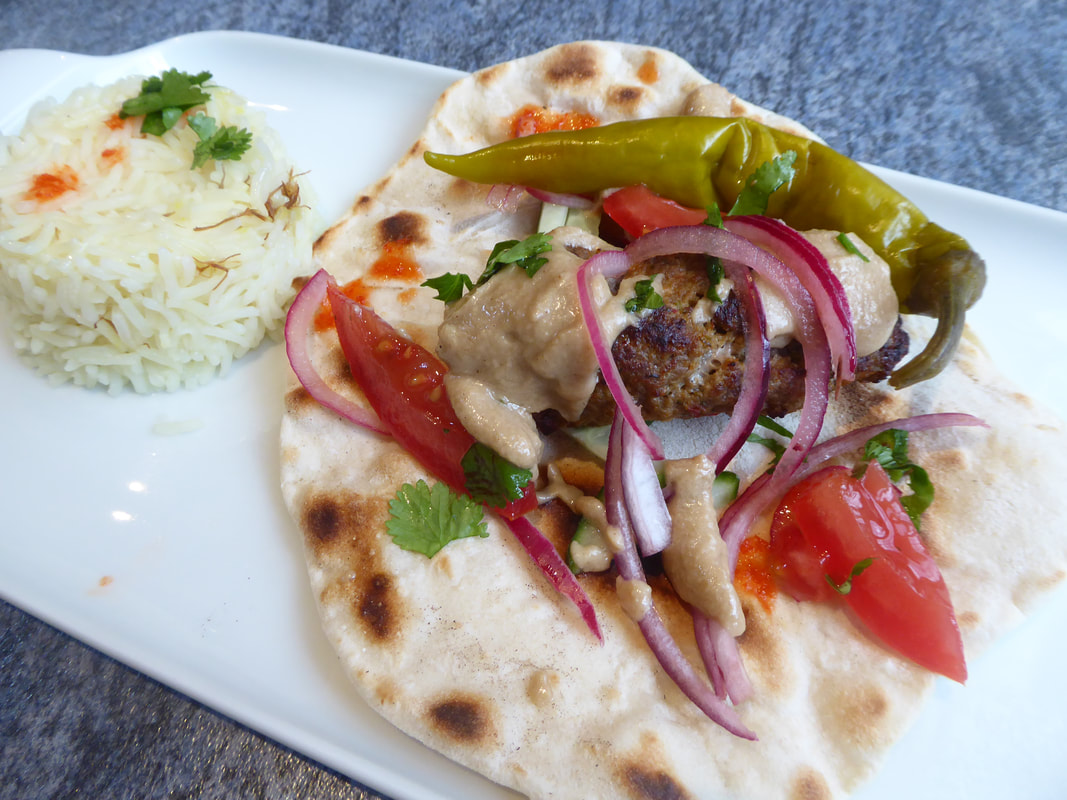
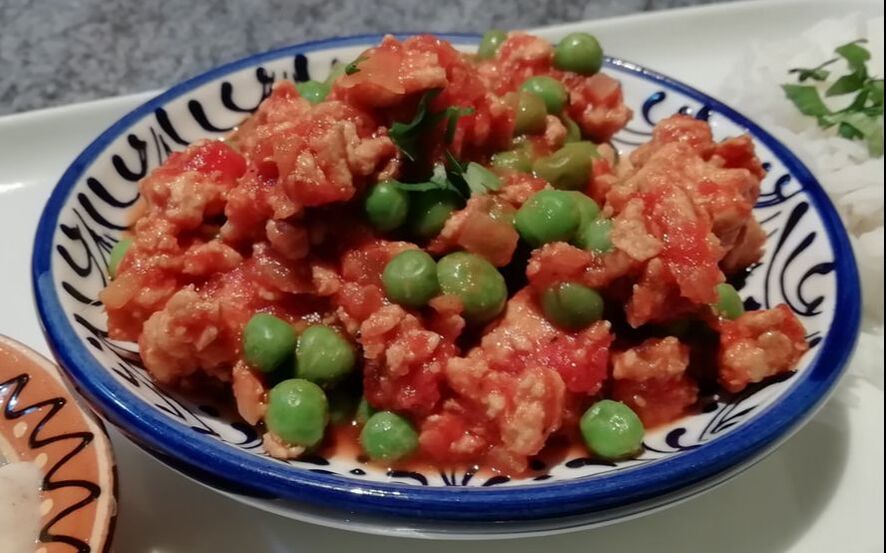
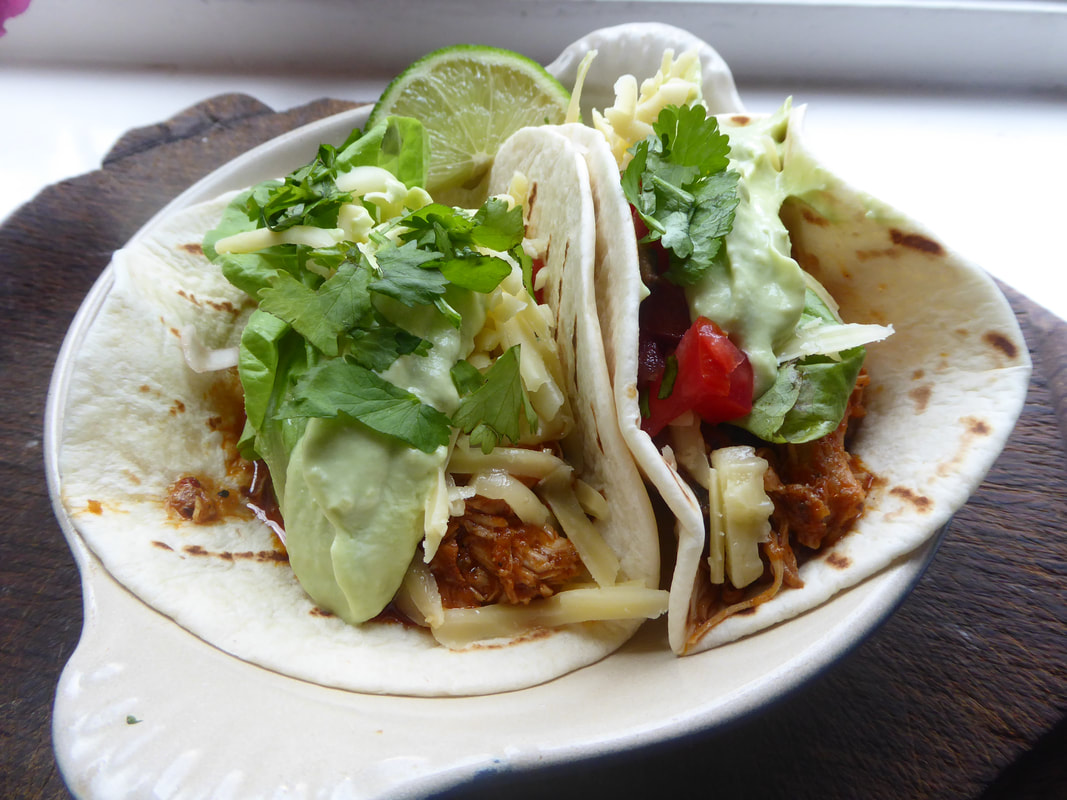
 RSS Feed
RSS Feed
